#3d tekla modeling
Explore tagged Tumblr posts
Text
Tekla Detailing Services
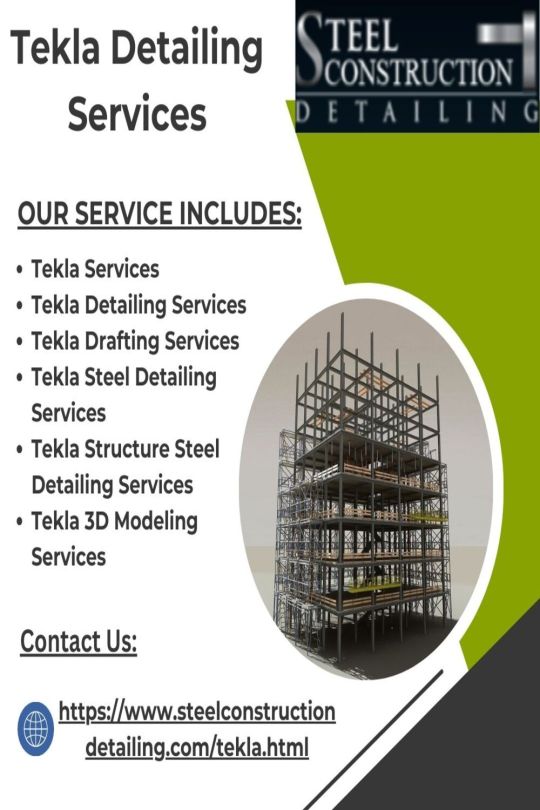
Our Steel Detailing Company provides Tekla Detailing Services in Los Angeles, USA. Tekla Steel Detailing is a software solution used by engineers and fabricators for creating 3D models of structures using BIM(Building Information Modeling) for effective fabrication. By using Tekla 3D Modeling Services, companies can simplify the process, reduce errors, and ensure high-quality outputs.
If you need these Cost-Effective and Durable Tekla Detailing Services, contact us today at Steel Construction Detailing Company.
For More Information, Visit Our Website:
0 notes
Text
https://www.adept-engineering.com
Why 3d modelling and detailing important in steel structure engineering?
The Importance of 3D Modeling and Detailing in Steel Structure Engineering
In the world of construction and engineering, precision and accuracy are paramount, especially when dealing with steel structures. The advent of 3D modeling and detailing has revolutionized how these structures are designed, fabricated, and erected. This technology not only enhances the efficiency of the construction process but also ensures the integrity and safety of the final product.
Enhanced Visualization and Design Accuracy
One of the most significant advantages of 3D modeling in steel structure design is the ability to visualize the entire structure before construction begins. Traditional 2D drawings often leave room for interpretation, which can lead to errors in the construction phase. With 3D modeling, engineers and designers can create a virtual representation of the structure, allowing them to see the exact dimensions, connections, and potential interferences. This detailed visualization helps in identifying design flaws early, reducing the need for costly changes during construction.
Improved Collaboration and Communication
3D modeling facilitates better collaboration among all stakeholders involved in the project, including architects, engineers, fabricators, and contractors. By working with a detailed 3D model, all parties can view the same information, leading to fewer misunderstandings and better communication. This collaborative approach ensures that everyone is on the same page, which is crucial for the successful completion of any construction project.
Precision in Fabrication and Construction
The accuracy provided by 3D modeling translates directly into the fabrication and construction phases. Detailed 3D models can be used to generate precise shop drawings and material lists, ensuring that all components are fabricated to exact specifications. This precision reduces waste, minimizes errors, and leads to a more efficient construction process. Additionally, the ability to detect and resolve potential issues before they occur on-site can save time and resources.
Risk Mitigation and Safety
Safety is a critical concern in any construction project, particularly when dealing with steel structures. 3D modeling allows engineers to conduct thorough analysis and simulations, assessing how the structure will perform under various conditions. By identifying and addressing potential issues before construction begins, 3D modeling helps mitigate risks and enhances the overall safety of the structure.
Conclusion
The importance of 3D modeling and detailing in steel structure engineering cannot be overstated. From enhanced visualization and design accuracy to improved collaboration, precision in fabrication, and risk mitigation, this technology plays a crucial role in modern construction practices. By adopting 3D modeling, the industry can continue to push the boundaries of innovation, ensuring the creation of safe, efficient, and cost-effective steel structures.
#3d modeling#connection design#steel detailing services#steel fabricators#structural steel detailing services#advance steel#tekla#sds2
1 note
·
View note
Text
Explore Charleston’s Best Miscellaneous Steel Detailing Services Provider, USA AEC Sector
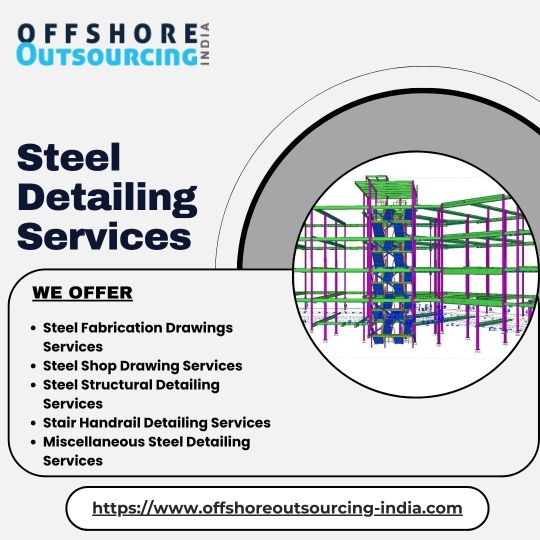
Offshore Outsourcing India's team of best tekla detailers offers you best-in-class Miscellaneous Steel Detailing Services with their upper-hand Structural Steel Modeling software expertise, digitalizing your steel detailing project to give you every-minute design insights by ensuring clear communication, minimizing steel fabrication errors and faster project completion. We go beyond CAD Drawings by providing collaborative planning, seamless design integration, and value engineering to ensure cost savings and efficient project execution. Our CAD outsourcing services are customized to your building project's needs, offering a cost-effective CAD solution that meets your budgetary constraints and quality standards.
Our Services
Steel Fabrication Drawings Services
Steel Shop Drawing Services
Structural Steel Detailing Services
Stair Handrail Detailing Services
Joist Steel Detailing Services
Tekla Steel Detailing Services
We offer affordable CAD Drawing and Drafting Services globally, with countries like the United States, Canada, Germany, France, United Kingdom, Australia, Spain, Italy, Netherlands, Sweden, Denmark, Singapore, South Korea, Brazil, Saudi Arabia, Qatar, United Arab Emirates, Bahrain, Austria, Finland, Ireland, Switzerland, etc.
For more details click on the link below
Please Read our latest blog post and explore more
#Steel Detailing#Structural Steel#3D Modeling#Tekla Detailing#AEC#USA#UAE#UK#Qatar#Saudi Arabia#Germany
0 notes
Text
MEP Coordination Services for Residential Apartment Project
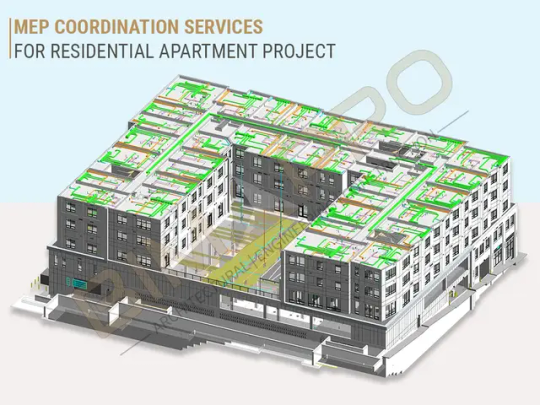
Setup of MEP coordination services framework presents a significant challenge for complex Apartment projects. Today, residential projects are so complex that specialized contractors and consultants with experience are needed to execute them within the given budget and timeframe.
However, due to a lack of awareness of various digital tools available in the market, consultants and contractors often use semi-digitalized methods for executing MEP projects, in which design coordination is done through AutoCAD plans, while the most critical part, clash detection, is done manually.
This approach often results in identifying different service clashes during the execution stage, which leads to rework, time consumption, and cost overruns. Sometimes, the cost of this rework is so high that it negatively affects the project, resulting in cost overruns, time overruns, and reducing the profits of all parties involved.
MEP Coordination Using BIM Technology
In the construction industry, the mechanical, electrical, and plumbing (MEP) systems of a facility can represent up to sixty percent of its total cost. Given this significant figure, coupled with the challenges of routing each of these systems, MEP coordination becomes a high priority in the Residential apartment design of constructions.
This coordination typically involves the trade contractors and other responsible parties such as engineers and VDC coordinators, who work together to integrate their systems into the apartment building. Traditionally, this process involved a time-consuming overlay of drawings to identify clashes and route the MEP systems.
With the development of computer-aided design (CAD), this process became faster and replaced the traditional approach. However, with the introduction of Building Information Modeling (BIM) technologies, new processes have emerged that include clash detection and highly detailed visualizations, taking MEP coordination for Apartment project to the next level.
Some of the BIM software can be used for effective MEP coordination are Autodesk’s Revit, Navisworks, BIM360 Glue, Procore, Tekla, Trimble Connect, and more.
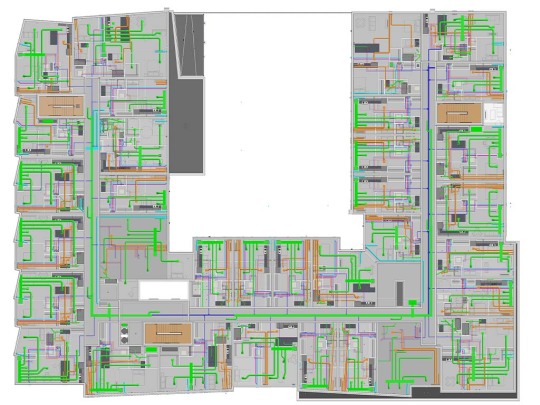
BIM-based MEP Coordination Services for Apartment Projects
BIM-based MEP coordination services ensure that the MEP systems of the apartment project are designed, coordinated, fabricated, installed and construct correctly and efficiently. BIM coordination services facilitate collaboration among various stakeholders involved in the BIM construction project including architects, MEP engineers, general contractors, MEP contractors, and other trades.
The BIM Model allow all stakeholders a digital representation of physical and functional characteristics of the MEP systems of building’s facility.
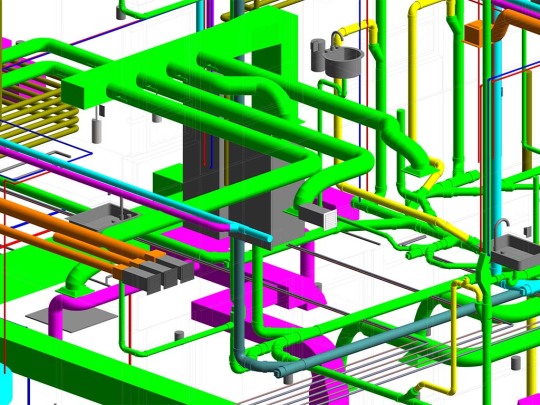
MEP Coordination Process for Apartment Project
The BIM MEP coordination process usually begins with the creation of a 3D model of the building, which includes the architectural, structural, and MEP systems. Each MEP system is then modeled in detail, including ductwork, piping, conduits, and other components.
The model is then analyzed for potential clashes between different systems or components. These clashes are resolved by adjusting the position or configuration of the affected components in the model.
Once the coordination process is complete, the final 3D model serves as a basis for generating detailed shop drawings, fabrication models, and installation drawings.
Use Standard MEP Template
Use company standard MEP template for modeling which include MEP components.
Positioning MEP model with Architectural Model
Add architectural model coordinates to MEP model and positioning them by using the “Origin to Origin” approach.
Create Levels and Grids for MEP Model
Align the levels and grids of MEP model with the base model (architectural and structural model)
Create MEP Worksets
Creating worksets to show and hide the mechanical, electrical, plumbing, fire protection elements for better visualization.
Develop MEP-FP Model
Create highly detailed and accurate 3D MEP Model based on the required BIM LOD, BEP (If available), specifications, drawings, and client’s input.
Run Clash Detection
Run interdisciplinary Clash detection between architectural, structural, mechanical, electrical, plumbing, fire protection systems and generate clash reports.
Review and resolve
All clashes’ elements can be identified by their clash ID and that can be fixed in the Revit file. Some complicated clashes can be reviewed and resolved with the contractors and design team by generating RFI, clash reports and change orders.
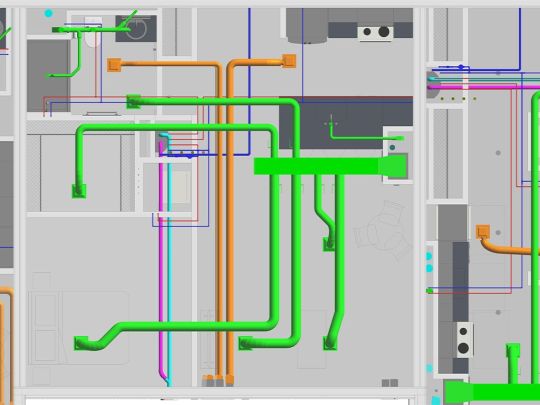
Benefits of BIM MEP Coordination Services
Clash Detection and Resolution – Identify and resolve the clash between multiple disciplines before the construction begins.
Optimum Space Utilization – Optimal utilization of available space to maximize functionality of MEP design layouts.
Enhance Building Performance – It ensures that all MEP components works seamlessly throughout the project lifecycle, facilitating energy efficiency, sustainability, operational effectiveness.
Save Cost Overrun – Resolution of clash errors in the early phase of design and construction can reduce the reworks, material wastage and facilitate the cost savings.
Streamline Construction Schedules – Facilitate smoother construction schedules by minimizing the disruption caused by clashes and delays.
Mitigate Risk – It provide safe working environment by eliminating hazards and ensure safety regulations, thus mitigating the risk associated with MEP systems during the construction and operation phase.
Effective Collaboration – It provide a collaborative platform for all team members where they can communicate effectively to facilitate the smooth decision making process.
Conclusion
In conclusion, MEP coordination services are a critical method for apartment’s design and construction project. With the advent of BIM technology, MEP coordination has become more efficient and effective, reducing the risk of rework, delays and cost overruns. BIM software allows all stakeholders to work collaboratively on a project, identify potential clashes and solve them before construction begins. This results in a more streamlined construction process, better quality control and ultimately, successful project outcomes.
#MEPCoordinationServices#BIMCoordinationServices#MEPRevitModelingServices#MEPRevitServices#RevitMEPServices#MEPBIMCoordinationServices#MEPservicesinconstruction#MEPCoordinationModeling
1 note
·
View note
Text

🔍 Capture. Convert. Create. At Silicon Engineering Consultants Ltd, our As Built BIM Services bring real-world structures to life in 3D with pinpoint accuracy! 🏗️✨ Using AutoCAD & Tekla, we deliver high-quality digital models for seamless planning and execution. 🚀 Ready to transform your project? Let’s build smarter!
Visit us at: https://www.siliconc.co.nz/bim-services/as-built-bim/
#AsBuiltBIMService#PointCloudBIMService#AsBuilttoBIMModelingService#AsBuilttoBIMOutsourcingService#BIMShopDrawingService#bimServices#cadservice
1 note
·
View note
Text
Rebar Detailing Services in Manchester,UK
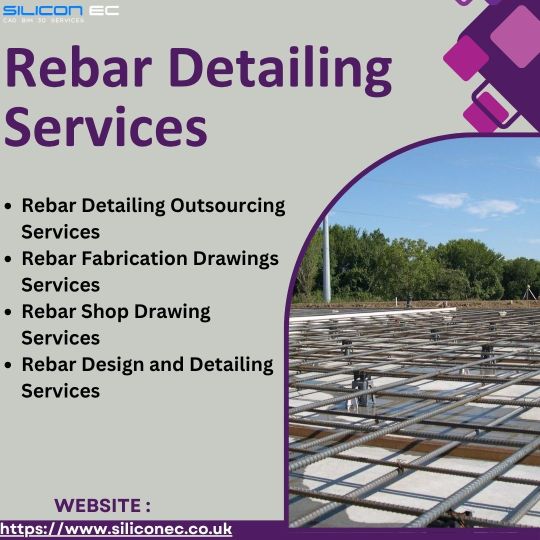
Silicon EC UK Limited Provides Rebar Detailing Services in Manchester, UK. We offer Rebar Detailing Outsourcing Services to support contractors, fabricators and structural engineers with cost-effective, time-saving solutions. Our team delivers highly accurate Rebar Fabrication Drawings Services, ensuring smooth reinforcement placement and compliance with international codes. Our expertise in Tekla Rebar Detailing Services can create intelligent 3D models for clash detection, quantity takeoffs and constructability review. We also provide Rebar Design and Detailing Services that support every phase of your structural reinforcement plans. Our accurate and detailed Rebar Shop Drawing Services help reduce errors and ensure efficient site execution. Our cutting edge 3D Rebar Detailing Service delivers a complete visual representation of reinforcement layouts to aid in better understanding and project planning. Our Rebar Detailing Solutions can ensure the highest quality, timely delivery and support throughout your project's lifecycle.
Get in touch with our expert team today to discuss your rebar detailing needs. We’re here to deliver precise, cost-effective solutions tailored to your project requirements. Contact us now for professional guidance and reliable support throughout your construction journey.
For More Information:-- https://www.siliconec.co.uk/services/rebar-detail.html
0 notes
Text
Steel Connection Design Services: Ensuring Strength and Stability in Every Joint
In structural engineering, a steel structure's integrity depends on its members and how they're connected. Whether it's a skyscraper, bridge, or industrial facility, steel connections are the unseen forces that hold everything together. This is where Steel Connection Design Services become essential, ensuring that each joint, weld, and bolt contributes to a structure’s overall strength, safety, and performance.
From the smallest gusset plate to complex moment frames, proper connection design is critical to structural resilience. These connections must be engineered to transfer loads accurately, resist movement, and comply with codes and safety standards. Professional connection design plays a key role in balancing safety, constructability, and cost-efficiency.
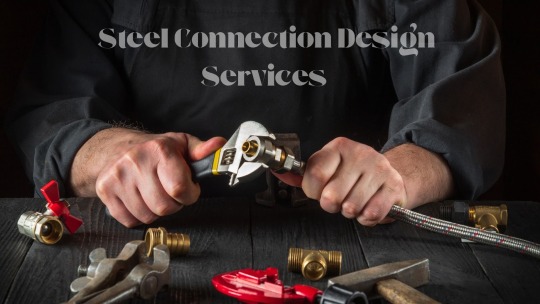
What Are Steel Connection Design Services?
Steel connection design services involve the engineering analysis and detailing of how steel structural elements, such as beams, columns, and braces, are joined together. The goal is to ensure these connections can safely transfer axial forces, bending moments, shear, and torsional loads between members under various conditions, including seismic and wind loads.
These services typically include
Design of bolted and welded connections
Shear, moment, and axial connections
Base plate and anchor bolt design
Connections, calculations, and modelling
3D detailing and shop drawings
Connection design specialists use advanced software and engineering methods to make sure each joint in a steel framework works well under pressure.
Types of Steel Connections
There is no universal solution for connection design. Depending on the structure's function, location, and load requirements, different connection types are used:
1. Bolted Connections
These are the most common in modern steel construction due to ease of installation and removal. Bolted connections include:
Shear connections (simple)
Moment connections (rigid)
Seated and end-plate connections
2. Welded Connections
These offer high strength and rigidity and are often used where load paths are complex or visual appeal is crucial. Although welded connections are precise, they require skilled labor and stringent quality checks.
3. Hybrid Connections
Some structures benefit from a combination of bolting and welding, taking advantage of both types' strengths while minimizing their limitations.
Importance of Steel Connection Design
1. Structural Safety
Poorly designed connections are a common point of failure in buildings during extreme events like earthquakes or heavy wind loads. Precision in connection design ensures that load paths are predictable and secure.
2. Code Compliance
Connection designs must meet international and regional codes such as AISC (American Institute of Steel Construction), Eurocode, IS 800 (India), and others. Experienced engineers ensure every detail is code-compliant and certifiable.
3. Constructability
Well-designed connections simplify fabrication and erection. Engineers consider accessibility, fabrication methods, and construction sequences to minimize field complications and reduce labor costs.
4. Cost Efficiency
Connection optimization can significantly reduce the quantity of steel, welding, or bolts needed, ultimately lowering project costs without compromising safety or performance.
Tools and Technologies Used in Connection Design
Today’s connection design relies on a range of advanced software tools and technologies. Some commonly used platforms include
STAAD.Pro and ETABS for structural analysis
IDEA StatiCa, RAM Connection, and Tekla Structures for steel connection design
AutoCAD, Revit, and Advance Steel connection design services are used for detailed drafting and 3D modeling.
These tools allow engineers to simulate real-world load scenarios, check for stress distribution, and produce detailed fabrication-ready drawings.
Industries that Rely on Steel Connection Design
Steel connection design services are crucial across multiple sectors:
Commercial Construction: Office buildings, malls, and hotels rely on moment-resisting frames and column-beam connections.
Industrial Facilities: Warehouses, factories, and plants require robust bolted/welded connections to support machinery and equipment.
Infrastructure Projects: Bridges, flyovers, towers, and stadiums require advanced connections that can bear dynamic loads.
Energy Sector: Oil & gas rigs, transmission towers, and solar panel structures depend on reliable steel joint design.
Why Hire Professional Steel Connection Designers?
Hiring experts in connection design offers numerous benefits:
Accuracy & Safety: Licensed structural engineers bring the expertise needed for safe and code-compliant joints.
Time Efficiency: With optimized detailing and analysis, professionals streamline the design-to-construction pipeline.
Customization: Each project receives tailored solutions based on its structural layout, load paths, and construction methods.
Coordination with Fabricators: A good connection design minimizes fabrication errors, delays, and on-site issues by aligning closely with shop drawing requirements.
What to Expect from a Connection Design Partner
An ideal connection design service should provide the following offerings:
Preliminary connection concepts based on architectural intent
Load-based calculation reports and design sheets
Fabricator-friendly shop and erection drawings
On-call support during fabrication or construction
Revisions and optimisations based on feedback
A collaborative approach ensures the connections are not only structurally sound but also practical to implement in real-world conditions.
Conclusion:
Discuss the importance of structural integrity in ensuring safety and longevity in connection designs.
Explore how design collaboration between engineers and architects can lead to more innovative solutions.
Explain how to handle real-world implementation issues that might come up while building.
Outline the relevant engineering standards that guide connection design and ensure compliance with regulations.
Consider sustainability factors in connection design, including material choices and energy efficiency.
While the public often overlooks connections, engineers and builders view them as crucial components of a structure. Properly engineered steel connections enhance a structure's strength, durability, and performance across its lifecycle. Whether you're constructing a high-rise building or an industrial facility, reliable Steel Connection Design Services ensure peace of mind and long-term value.
#SteelConnectionDesign#StructuralEngineering#ConnectionDesignServices#BoltedConnections#WeldedConnections
0 notes
Text
Why Structural Detailing Services Are Crucial in Modern Construction
In today’s fast-paced construction environment, precision is everything. From large-scale industrial facilities to commercial complexes, structural steel detailing plays a vital role in transforming architectural concepts into reality.
Companies aiming for efficiency and accuracy turn to trusted detailing partners. Moldtek Engineering is one such leader, known for its expertise in delivering high-quality steel detailing services for diverse projects across the globe.
Their experienced team produces fabrication drawings, erection plans, and 3D BIM models that improve coordination between engineers, fabricators, and contractors. By streamlining workflows, reducing on-site errors, and enabling faster project completion, such services bring unmatched value to construction professionals.
Whether it's a commercial building or an industrial plant, every steel member must be accounted for — from beam connections to anchor bolt placements. This is where detailers make the difference. And with increasing demand for automation, advanced detailing software tools like Tekla Structures and AutoCAD are being used to deliver highly accurate results.
If you're looking for reliable, cost-effective, and technically sound support for your upcoming projects, don’t miss the detailing expertise offered at Moldtek Engineering.
0 notes
Text
Understanding Automotive Wiring Harnesses and BIM Training Institutes in Pune
Automotive Wiring Harness: The Nervous System of Vehicles
An automotive wiring harness is an essential component that acts as the nervous system of a vehicle. It consists of a complex network of wires, connectors, and terminals that transmit electrical signals and power throughout the automobile. These harnesses are responsible for connecting various electrical and electronic components such as lights, sensors, engine controls, and entertainment systems.
The design and manufacturing of wiring harnesses require precision and expertise to ensure safety, reliability, and durability under various operating conditions. Advances in automotive technology, including electric vehicles (EVs) and autonomous driving systems, have increased the complexity and importance of wiring harnesses. Modern harnesses are now designed to handle higher voltages, incorporate sophisticated routing, and meet stringent safety standards.
Professionals involved in the automotive wiring harness industry typically undergo specialized training in electrical systems, automotive electronics, and manufacturing processes. This knowledge ensures that they can produce harnesses that are efficient, safe, and compliant with industry standards.
Bim Training Institute in Pune: Building the Future with BIM Skills
In the construction and architecture sectors, BIM (Building Information Modeling) has revolutionized project planning, design, and management. The Bim Training Institute in Pune offers comprehensive courses that equip students and professionals with the necessary skills to excel in BIM technology. These courses cover essential topics such as 3D modeling, clash detection, project visualization, and construction management.
Pune has emerged as a hub for engineering and architectural education, making it an ideal location for Bim Software Classes in Pune. These institutes focus on hands-on training, providing learners with practical experience in popular BIM software tools like Revit, Navisworks, and Tekla Structures. The goal is to prepare students for the dynamic demands of the industry, where BIM professionals are highly sought after for their ability to streamline workflows, reduce costs, and improve project outcomes.
Structural Design Courses: Laying the Foundations
Complementing BIM training, structural design courses are vital for those interested in the structural engineering domain. These courses delve into the principles of designing safe and efficient structures, including buildings, bridges, and industrial facilities. Students learn about load calculations, material properties, seismic considerations, and sustainable design practices.
Structural design courses also incorporate software training, enabling students to create detailed structural models and analysis reports. Combining these skills with BIM expertise enhances a professional’s ability to contribute effectively to construction projects, ensuring structural integrity and compliance with safety standards.
The Intersection of Technology and Industry
Both the automotive wiring harness sector and the architectural/structural design fields are experiencing significant technological advancements. Automation, digital modeling, and computer-aided design tools have transformed how professionals approach their work. For instance, the integration of BIM in construction projects improves coordination and reduces errors, much like how advanced wiring harness designs optimize vehicle performance and safety.
Furthermore, educational institutions in Pune are adapting to these changes by offering specialized courses that blend traditional engineering principles with modern software skills. The Bim Training Institute in Pune and various structural design courses are examples of how education is evolving to meet industry needs.
Conclusion
Whether you're interested in the technical intricacies of automotive wiring harness manufacturing or aiming to enhance your skills through Bim Software Classes in Pune or structural design courses, Pune offers excellent opportunities for professional growth. Staying updated with the latest industry standards and technological advancements is crucial for success in these dynamic fields.
0 notes
Text
The Role of Steel Detailing in Modern Construction Projects
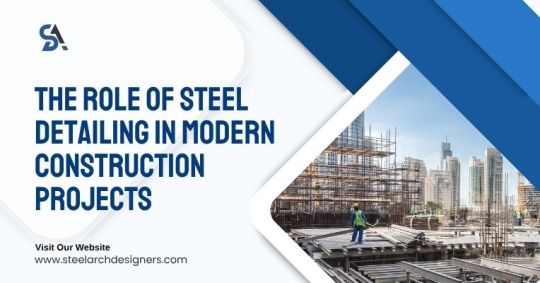
In today’s fast-moving construction industry, accuracy, coordination, and efficiency are more important than ever. One critical part of this process, often working quietly in the background, is steel detailing.
At Steelarch Designers, we believe steel detailing is not just about drawings. It is about transforming ideas into reality by ensuring that every steel component fits perfectly into the overall design. Let us take a closer look at how steel detailing plays a major role in modern construction projects.
What is Steel Detailing?
Steel detailing is the process of creating detailed drawings and models for the fabrication and erection of structural steel components. These include beams, columns, stairs, trusses, handrails, and more.
This process serves as the link between design and construction. It takes the architect’s vision and the engineer’s calculations and turns them into detailed, shop-ready instructions for fabricators and on-site teams.
Why is Steel Detailing Important in Construction?

Modern buildings are complex and often built under tight deadlines. A single mistake in the drawings can lead to expensive delays, material waste, and safety concerns. That is why steel detailing is so important. Here are the main reasons it plays a key role:
1. Accuracy and Precision
Every bolt, cut, and weld matters. Steel detailing ensures that all measurements are accurate. A small mistake in a drawing can result in steel pieces not fitting together properly.
At Steelarch Designers, we use the latest software and tools to produce accurate drawings that ensure all components align perfectly during fabrication and erection.
2. Clear Communication Between Teams
Steel detailers act as the connection between designers and builders. We produce both shop drawings for fabricators and erection drawings for site crews.
These drawings are clear and easy to understand, helping different teams work together without confusion. Good communication means fewer errors, faster progress, and better results.
3. 3D Modeling for Better Visualization
Today’s technology allows us to go beyond flat 2D drawings. We use advanced 3D modeling tools like Tekla Structures and AutoCAD to create models that show exactly how the structure will look and function.
3D models make it easier to visualize the project. They help identify clashes early and improve coordination between architects, engineers, and contractors.
4. Saves Time and Reduces Costs
Accurate steel detailing helps projects stay on schedule and within budget. When the drawings are correct, fabrication is smoother, and construction goes faster.
There is less rework, fewer material mistakes, and better use of labor. At Steelarch Designers, we focus on helping clients save time and money by getting every detail right from the start.
5. Ensures Code Compliance
Construction projects must follow local and international codes and standards for safety and quality. Steel detailing makes sure every component meets these standards.
Our team at Steelarch Designers stays updated on the latest codes like IS codes, AISC, and British Standards to ensure that your project is fully compliant.
6. Supports Complex Architecture
Architects are constantly pushing creative boundaries with bold designs and large open spaces. Steel detailing helps turn these ideas into buildable structures.
Whether it is a curved roof, a floating staircase, or a unique steel frame, detailed drawings allow builders to execute even the most complex designs with confidence.
How Steel Detailing Works on a Construction Site

Think about a commercial building under construction. The architect shares the concept. The engineer calculates the load requirements. But it is the steel detailer who creates the drawings showing where each beam fits, how each column connects, and where every bolt goes.
Thanks to accurate steel detailing, fabricators know what to cut and weld. Site crews know how to assemble everything safely and quickly. The result is a building that comes together smoothly, with no surprises.
Why Choose Steelarch Designers for Steel Detailing?
At Steelarch Designers, we bring together years of experience, skilled professionals, and the latest tools to deliver top-quality steel detailing services. Here is what you can expect when you work with us:
Clear and accurate shop and erection drawings
Smart 3D modeling for better planning and visualization
Fast delivery timelines to keep your project on track
Responsive and friendly customer support
We work on a wide range of projects including commercial buildings, factories, warehouses, bridges, and more. No matter the size or complexity of the job, our goal is to make your vision a reality with reliable and efficient detailing.
Conclusion
Steel detailing is a crucial part of any construction project. It ensures that every steel element is fabricated and installed correctly. From improving accuracy and reducing costs to enhancing safety and design, the role of steel detailing cannot be ignored.
If you are planning a steel structure and want to ensure smooth execution from start to finish, trust Steelarch Designers. We are here to support your success with every beam, bolt, and bracket.
Let us bring your steel structure to life with precision and professionalism.
Know More: https://www.steelarchdesigners.com/blog/steel-detailing-modern-construction.php
0 notes
Text
Tekla 3D Modeling Services
Our Steel Construction Detailing Company provides Tekla 3D Modeling Services in Texas, USA. Tekla Structures is a software solution for creating 3D models of structures, enabling efficient design, detailing, and information management throughout the project lifecycle, from conceptual planning to fabrication, construction, and maintenance.
If you need these Cost-Effective and Durable Tekla 3D Modeling Services, contact us today at Steel Construction Detailing Company.
For More Information, Visit Our Website:

0 notes
Text

Top Civil BIM Course 2025: Master Revit, Navisworks & More
Introduction
As the construction and infrastructure industries continue to grow, Building Information Modeling (BIM) has become an essential tool for civil engineers. BIM helps in planning, designing, and managing construction projects more efficiently by offering a digital representation of physical and functional characteristics of structures. In 2025, several top BIM courses are available to help civil engineering professionals upskill and meet the demands of modern construction projects. This blog highlights some of the best civil BIM courses to consider this year.
Why BIM is Important in Civil Engineering
BIM plays a crucial role in improving project accuracy, coordination, and efficiency. It allows civil engineers to visualize the entire construction process before it begins, helping to reduce errors, save time, and control costs. By learning BIM, civil engineers gain the ability to collaborate better with architects, contractors, and other stakeholders. The integration of BIM in infrastructure projects ensures better communication and decision-making, which is why many organizations now require BIM proficiency as a standard skill.
Best Civil BIM Courses to Consider in 2025
Several institutions and training centers are offering quality BIM courses specifically designed for civil engineers. These courses focus on the use of various BIM tools such as Autodesk Revit, Civil 3D, Navisworks, Tekla Structures, and others. The courses range from beginner to advanced levels and cover real-world applications, ensuring that students and professionals are job-ready upon completion.
A typical civil BIM course in 2025 includes modules on 3D modeling, quantity takeoff, clash detection, coordination, and project scheduling. Many of these programs also include hands-on training and live project work, which helps learners gain practical experience.
There are full-time, part-time, and online options available, allowing learners to choose based on their schedule and learning preference. Some of the top-rated programs also offer placement support, career counseling, and certification, which adds value to your resume and helps improve your chances of landing a job in the field.
Skills You Will Gain
By enrolling in a civil BIM course, you will gain a variety of technical and analytical skills. These include:
Proficiency in BIM software such as Revit, Navisworks, and Civil 3D
Understanding of 3D and 4D modeling techniques
Project coordination and clash detection
Knowledge of construction documentation and scheduling
Ability to collaborate with multi-disciplinary teams
In addition to these technical skills, you’ll also develop soft skills such as teamwork, communication, and problem-solving—all of which are crucial in large-scale construction projects.
Who Should Enroll
These courses are ideal for:
Civil engineering students looking to specialize in construction technology
Working professionals who want to upgrade their skill set
Site engineers, project managers, and CAD technicians
Anyone aiming to build a career in infrastructure development and digital construction
Whether you’re a beginner or an experienced engineer, there’s a BIM course tailored to your level. You can choose a beginner-level course to understand the basics or opt for an advanced program that focuses on project execution and real-time coordination.
Conclusion
In 2025, BIM continues to transform how civil engineering projects are designed, managed, and executed. Learning BIM is no longer optional but a necessity for anyone involved in modern construction. The top civil BIM courses available today are designed to equip you with the right tools and techniques to succeed in the field. With growing demand for BIM professionals across industries, enrolling in a BIM course is a smart investment for your future career in civil engineering.
0 notes
Text
Navisworks Vs Revizto – Best Tools for BIM Coordination & Clash Detection
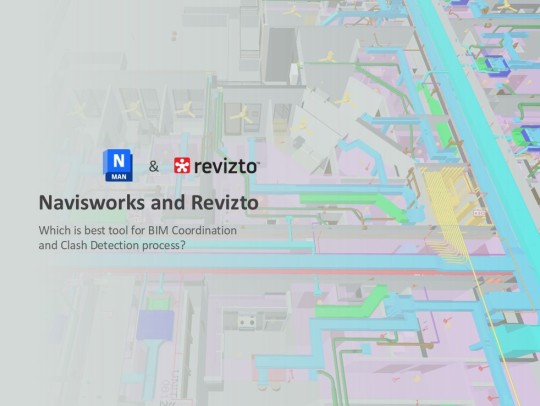
Navisworks vs Revizto: Choosing the Best Tool for BIM Coordination and Clash Detection
When you’re managing a BIM project, the software tools you choose can make a world of difference. Navisworks and Revizto are two major players in this space, each with its own strengths and weaknesses. Whether you’re focused on detailed clash detection or ensuring your team is always on the same page, understanding what each tool offers is key to making the right choice. Let’s dive into a detailed comparison of Navisworks and Revizto to help you decide which one suits your project needs.
Navisworks: The Go-To for Detailed Clash Detection
When you’re managing a BIM project, the software tools you choose can make a world of difference. Navisworks and Revizto are two major players in this space, each with its own strengths and weaknesses. Whether you’re focused on detailed clash detection or ensuring your team is always on the same page, understanding what each tool offers is key to making the right choice. Let’s dive into a detailed comparison of Navisworks and Revizto to help you decide which one suits your project needs.
What Makes Navisworks Stand out?
1. In-Depth Clash Detection:
Pinpointing Every Issue: Navisworks excels at clash detection. Imagine you’re working on a large hospital project. You’ve got structural steel, HVAC systems, plumbing, and electrical conduits all trying to occupy the same space. Navisworks helps you identify where these elements clash with each other—whether it’s a steel beam running into ductwork or plumbing pipes colliding with electrical conduits.
Types of Clashes: Navisworks identifies both hard clashes (physical overlaps) and soft clashes (proximity issues that might cause problems, like inadequate clearances). This dual capability ensures nothing slips through the cracks, giving you the insight needed to address potential problems before they become costly errors on-site.
2. Model Aggregation:
Bringing It All Together: Navisworks can aggregate models from different sources into a single, cohesive environment. For example, you can pull in architectural models from Revit, structural models from Tekla, and MEP systems from AutoCAD or other software. This makes Navisworks particularly valuable for complex projects where coordination between various disciplines is critical.
Support for Multiple File Formats: It doesn’t matter if your data is coming from .RVT, .DWG, .IFC, or other formats—Navisworks handles them all, allowing for seamless integration and a comprehensive project overview.
3. 4D Construction Simulation:
Visualizing the Construction Timeline: With 4D simulation, Navisworks adds the dimension of time to your 3D models. This means you can visualize the construction process step by step, seeing how different phases of the project will unfold over time. For instance, you can map out the sequence of installing structural elements, followed by MEP systems, and then finishes. This helps with scheduling, resource allocation, and identifying potential bottlenecks before they impact the project.
4. Material Takeoff and Quantification:
Accurate Material Estimates: Navisworks includes tools for quantifying materials directly from the model. This feature is crucial for cost estimation and procurement. For example, if you need to know exactly how much steel, concrete, or ductwork your project requires, Navisworks can generate these quantities, helping you plan your budget and orders more accurately.
5. Integration with Autodesk Ecosystem:
A Unified Workflow: Navisworks is part of the Autodesk suite, meaning it works seamlessly with other Autodesk products like Revit, AutoCAD, and Civil 3D. This integration simplifies workflows, especially for firms already embedded in the Autodesk ecosystem. You can move data between these applications without worrying about compatibility issues.
Challenges with Navisworks
Learning Curve: Complex but Rewarding Navisworks is powerful, but that power comes with complexity. It’s not the kind of software you can pick up in a day. Users often need substantial training and practice to master its features, especially when it comes to setting up clash detection rules and interpreting the results.
Hardware Demands: Need for High Performance Because Navisworks is processing large, detailed models, it can be quite resource-intensive. If your hardware isn’t up to par, you might experience slow performance, particularly when working with very large datasets or running extensive clash detection tests.
Revizto: The Collaboration Powerhouse
While Navisworks is all about detailed technical analysis, Revizto is designed to make collaboration effortless. It’s a tool that prioritizes keeping your team connected and ensuring everyone has access to the latest project information—regardless of their technical background.
Why Revizto is a Collaboration Game-Changer?
1. Real-Time Collaboration:
Instant Communication and Updates: Revizto is built for teamwork. Imagine your team is spread across different locations—some in the office, others on-site. Revizto allows everyone to collaborate in real-time, whether they’re marking up a model, leaving comments, or tracking issues. This means faster decision-making and fewer delays caused by miscommunication.
Centralized Data: All project data is centralized in Revizto, so you don’t have to worry about version control or fragmented communication. Everyone is working from the same, up-to-date information, which helps avoid costly mistakes and rework.
2. User-Friendly Interface:
Accessible to All: Revizto’s interface is designed with simplicity in mind. It’s intuitive enough that even those who aren’t BIM experts—like clients, project managers, or contractors—can easily navigate the platform. This broad accessibility ensures that everyone involved in the project can contribute effectively, without getting bogged down in technical details.
2D and 3D Navigation: Whether your team prefers working in 2D plans or exploring the project in 3D, Revizto makes it easy to switch between these views. This flexibility is especially useful for multidisciplinary teams where different members may have different preferences or expertise levels.
3. Issue Tracking and Management:
Keep Everyone Accountable: Revizto’s issue tracking is like a project management tool built into your BIM environment. When a problem is identified—say, a clash, a design flaw, or a construction discrepancy—it’s logged as an issue. You can assign it to the relevant team member, track its status, and ensure it gets resolved. This clear accountability helps keep the project on track and reduces the risk of issues slipping through the cracks.
Detailed Issue Logs: Each issue in Revizto is accompanied by rich data, including its location in the model, the date it was created, who it’s assigned to, and any relevant comments or attachments. This level of detail ensures that issues are thoroughly documented and easily trackable.
4. Clash Detection:
Simplified but Effective: While Revizto does offer clash detection, it’s not as detailed as what you’d find in Navisworks. However, it’s more than sufficient for many projects, especially those that don’t require deep technical analysis. Revizto’s clash detection is tightly integrated with its issue tracking, so clashes can be quickly assigned and addressed as part of the collaborative workflow.
5. Cross-Platform and Cloud-Based:
Work from Anywhere: Revizto’s cloud-based nature means that your team can access the platform from virtually anywhere—whether they’re on a desktop in the office, on a tablet on-site, or even reviewing plans on a smartphone. This flexibility is invaluable for projects where team members are often on the move or working from different locations.
Considerations When Using Revizto
Less Detailed Analysis: Not a Replacement for Advanced Clash Detection If your project requires highly detailed clash detection or complex model aggregation, Revizto might not fully meet your needs. It’s designed more for enhancing collaboration than for deep technical analysis. For such tasks, you might still need to rely on Navisworks or similar tools.
Focus on Communication: More About People, Less About Data Revizto shines in environments where communication and collaboration are the top priorities. If your project is highly technical and you need a tool for extensive data analysis, Revizto’s strengths might feel a bit secondary.
Making the Right Choice: Navisworks or Revizto?
Choosing between Navisworks and Revizto ultimately depends on what your project needs most:
Choose Navisworks if your project is technically complex and requires detailed clash detection, model aggregation from multiple disciplines, and advanced simulations. It’s the tool for when precision and depth are critical, and you have the resources to support its demands.
Choose Revizto if your priority is enhancing team collaboration, keeping everyone on the same page, and managing issues in real-time. It’s the ideal solution for projects where communication, accessibility, and simplicity are key, especially in multidisciplinary teams or projects with less technical oversight.
Conclusion
Both Navisworks and Revizto bring unique strengths to BIM coordination and clash detection. Navisworks is your go-to for detailed, in-depth analysis, making it indispensable for projects where technical accuracy is paramount. Contact BIMPRO LLC for clash detection Services. Revizto, on the other hand, is all about making collaboration seamless and ensuring that every team member, regardless of their technical expertise, can contribute effectively.
By carefully considering your project’s needs and the strengths of each tool, you can make an informed decision that enhances your BIM workflow, minimizes risk, and ensures successful project delivery.
#ClashdetectionServices#BIMCoordinationServices#ClashdetectioninBIM#ClashDetectionForNavisworks#NavisworksForBIMCoordination#ReviztoForBIMCoordination
1 note
·
View note
Text
Precast Panel Detailing Services in Manchester,UK
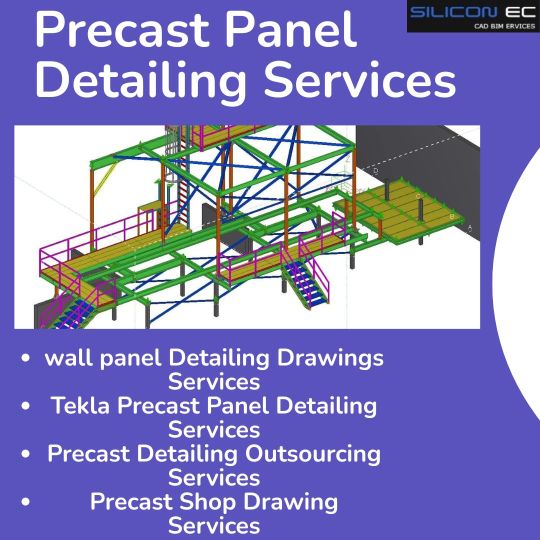
Silicon EC UK Limited Provides Precast Panel Detailing Services in Manchester, UK. We provide high quality wall panel Detailing Drawings Services ensuring that every wall component is accurately represented for smooth fabrication. Our expert team specializes in Tekla Precast Panel Detailing Services leveraging advanced software to deliver 3D models and shop drawings with maximum accuracy. We offer flexible Precast Detailing Outsourcing Services to help construction firms reduce overheads while maintaining consistent quality and on time delivery. Our Precast Shop Drawing Services provide detailed drawings that conform to AEC industry standards and streamline the construction process. Our Precast Concrete Detailing Services cover all components from foundations to façade panels ensuring each element integrates perfectly with the overall structure. We offer comprehensive Precast Stairs Detailing Services that create detailed plans and ensure proper load distribution.
For expert assistance with Precast Panel Detailing Services, reach out to our team today. We’re here to provide accurate, reliable, and cost-effective detailing solutions tailored to your project needs. Contact us now to discuss your requirements in detail.
For More Information:-- https://www.siliconec.co.uk/services/precast.html
0 notes
Text
Tekla Structural Steel Detailing: From Model to Manufacture HIQ Design Inc excels in Tekla Structural Steel Detailing, using one of the most advanced tools in the industry—Tekla Structures—to produce accurate and constructible 3D models. Steel detailing is essential to ensuring that every component fits perfectly on-site, and HIQ Design Inc delivers with exacting standards. For more details visit here:- https://hiqdesigninc.wixsite.com/hiqdesigninc/post/building-information-modeling
#tekla structural steel detailing in arizona#bim modeling in arizona#structural engineering company in arizona#structural engineering firm in arizona#structural contractors in arizona#steel structural design in arizona
0 notes
Text
CAD vs 3D Modeling: Understanding the Key Differences
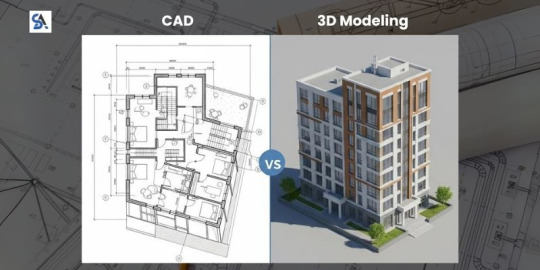
In the world of design and engineering, two terms often come up—3D Modeling and CAD (Computer-Aided Design). While many people use these terms interchangeably, they are not exactly the same. Both are powerful tools used in architecture, engineering, construction, and manufacturing, but they serve different purposes and have different capabilities.
At Steelarch Designers, we often work with both 3D Modeling and CAD software depending on the needs of the project. In this blog, we will explain what each term means, how they are different, and when to use which one.
What is CAD?
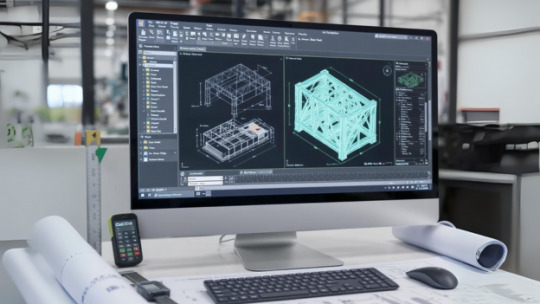
CAD stands for Computer-Aided Design. It is a type of software used to create precise 2D drawings and technical plans. CAD is widely used by engineers, architects, and draftsmen to prepare layouts, blueprints, and schematics for construction or manufacturing.
Common Uses of CAD:
Creating floor plans for buildings
Drafting engineering diagrams
Electrical and plumbing layouts
Machine part detailing
Popular CAD Software:
AutoCAD
SolidWorks
DraftSight
CAD is known for its accuracy and is ideal for creating detailed technical drawings that follow engineering standards.
What is 3D Modeling?
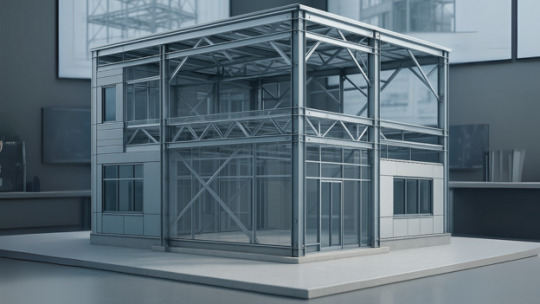
3D Modeling refers to the process of creating a digital three-dimensional object using specialized software. It is used to visualize real-world structures, products, or environments in a more realistic way.
Common Uses of 3D Modeling:
Visualizing buildings and interiors
Creating prototypes of products
Game and animation design
Simulations and walkthroughs
Popular 3D Modeling Software:
SketchUp
Blender
Revit
Tekla
3D models are more visual and are often used to present concepts to clients or to understand how a final structure will look.
Key Differences Between CAD and 3D Modeling
Let’s break down the key differences in a simple comparison:FeatureCAD3D ModelingPurposeTechnical drawings and plansRealistic visualization of objectsOutput Type2D drawings or 2.5D plansFully 3D modelsMain UsersEngineers, architects, draftsmenDesigners, architects, animatorsDetail LevelFocuses on dimensions, accuracy, specsFocuses on appearance and realismUse in ConstructionBlueprints, permits, and execution plansPresentations, conceptual visualizationSoftware ExampleAutoCAD, DraftSightSketchUp, Blender, RevitSkill RequirementTechnical drawing skillsDesign and visualization skills
Which One Do You Need?
The choice between CAD and 3D modeling depends on the stage and purpose of your project.
Use CAD when:
You need precise measurements and scaling
You’re working on structural and engineering designs
You need to prepare shop drawings, MEP layouts, or fabrication details
We often create 3D models of buildings and structures to help clients better understand how their finished project will appear.
Can CAD and 3D Modeling Work Together?
Absolutely! Many projects benefit from both. Here’s how:
Start with CAD to design the technical side of a product or building
Use 3D modeling to visualize how it will look in real life.
Combine both for a complete, accurate, and beautiful final presentation.
At Steelarch Designers, we often blend our CAD services with high-quality 3D modeling to give clients a full package, from blueprint to final look.
Making the Right Choice for Your Project
Let’s say you’re building a commercial structure with steel framing.
CAD is used to create precise shop drawings, column layouts, beam details, and fabrication drawings—essential for manufacturing and construction accuracy.
3D modeling, on the other hand, helps visualize the final structure with cladding, roofing, lighting, and finishes, giving the client a realistic view of the end result.
Both tools are equally important. Together, they ensure accuracy, clarity, and confidence throughout the entire process—from planning to execution.
Conclusion
Both CAD and 3D modeling are powerful tools in the design world, but they serve different purposes. CAD focuses on accuracy and detail for construction and manufacturing, while 3D modeling brings ideas to life through visuals.
At Steelarch Designers, we offer both CAD services and 3D modeling under one roof. Whether you're an architect, builder, entrepreneur, or homeowner, our team is here to help you choose the right tools for your project.
Have a project in mind? Let’s build something great together.
Contact Steelarch Designers today for expert CAD services and stunning 3D modeling that bring your ideas to life.
Know More: https://www.steelarchdesigners.com/blog/cad-vs-3d-modeling.php
0 notes